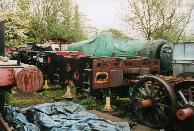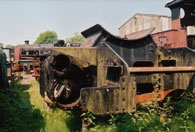78059
This locomotive was rescued from Barry Scrapyard with no tender.
There are other members of the class in existence and this member is being
converted to the tank engine version, of which none now exist. She
will become 84030.

In Sheffield Park yard. Work is proceeding on parts of the frames.
Her boiler is in the background under the green tarpaulin. The wheels
in front are those of the new Brighton Atlantic's tender. 31.03.02.

The front end of the locomotive, 16th June 2003.

The view from the other end, showing some of 78059's wheels. The
tank engine behind is P-class 31178. 16.06.03.

One of the smaller bogie wheels amongst the undergrowth, 16th June 2003.

The boiler, summer 2004.

84030's new chimney, with an information panel about the project above
it, 18th April 2003.
The information panel reads as follows:
The creation of a BR class 2 tank
The Project
This brand new chimney is part of a major project to re-create
an example of the final design of branch line tank engine, known as the
British Railways Standard class 2 tank.
30 of these locomotives were built, 20 at Crewe in 1953 and 10 at Darlington
during 1957. All were scrapped between 1963 and 1965.
The new BR class 2 tank

The beginnings
However, during the 1960's a South Wales scrap merchant
bought more than 200 redundant steam locomotives, of which 4 were of the
tender version and used the same boiler, cylinders, wheels etc as the tank
engine. Unique circumstances allowed these locomotives to remain in
existence for many years, and thus gave us the opportunity for them to be
purchased for preservation. Number 78059 was the last of the 4 to leave
the scrap yard in 1983, but the price of £9500 paid by the Bluebell
members did not include the tender. This had been removed and sold
to an unknown buyer some years before.
The old BR class 2 tender locomotive

The absence of a tender gave rise to the idea of converting
the locomotive in to the tank version, a costly exercise. Costs were
assessed and it was concluded that it would be cheaper to convert it than
to construct a new tender. This combined with the fact that a tank
locomotive would be more suitable for Bluebell operations where the engine
would be required to run backwards for half its day's duties, plus the desire
to re-create an otherwise extinct class of engine resulted in the decision
to proceed.
How do we proceed?
As with all restoration projects the remains are dismantled,
as you can see, they are then cleaned and inspected by Bluebell engineers.
Some of the parts will be refitted after simply repainting, others can be
repaired and reused, but some are suitable only as patterns from which
new ones can be remanufactured. This project however needs many additional
new parts because we are changing the design. Fortunately the National
Railway Museum holds many of the drawings from which the original locomotives
were made and we have purchased a number of these already.
Progress so far.
Work at present is concerned with inspection, refurbishment
and refitting valve gear. New parts are being made for the rear pony
truck and attention is also being given to the frames (chassis) with a view
to putting back the wheels, which have already been repaired and the axles
ultrasonically tested.
The frames need to be extended by about 8 feet. This will be made
as a separate unit complete with a rear buffer beam and the assembly welded
to the existing frames by a certified welder. This practice was commonly
used as a method of repair by Britain's railways. Completion of the
new rear pony truck, for which we already have the wheels, axle boxes, springs
and a number of smaller parts, will produce the "rolling chassis".
Work will then concentrate on making the new water tanks, cab and coalbunker.
The last item to be repaired will be the boiler, which preliminary inspections
have shown is very worthy of repair.
How long will it take and how much will it cost?
Completion of this project will take many years and cost
well in excess of £100,000 but it will produce a unique example of
a historically important locomotive.
We hope you found this summary of the Class 2 project of interest and perhaps
feel you are able to help Bluebell members recreate an "ideal" locomotive
with the aid of a small donation.
Thank you.







